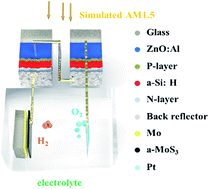Molybdenum-supported amorphous MoS3 catalyst for efficient hydrogen evolution in solar-water-splitting devices†
Abstract
We report molybdenum (Mo) metal-supported amorphous molybdenum sulfide (a-MoS3) catalysts with a porous and nanostructure nature, which exhibit excellent catalytic activity for the hydrogen evolution reaction (HER) in wired solar-water-splitting devices. Mo-supported a-MoS3 catalysts were prepared by wet chemically synthesizing a-MoS3 nanoparticles at room-temperature and then loading with Earth-abundant and scalable Mo metals sputtered at low temperature (100 °C). Electrochemical studies and applications in wired photoelectrochemical/photovoltaic (PEC–PV) solar-water-splitting devices reveal that the HER performance of wired PEC–PV solar-water-splitting devices can be efficiently enhanced with the proposed highly conductive Mo-supported a-MoS3 catalysts by enlarging the electrochemically active areas, accelerating the electron transport to active sites, and improving the charge transfer at the catalysts/electrolyte interfaces. The low-temperature preparation of highly active Mo-supported a-MoS3 catalysts paves the way to integrating them into various high-performance PV devices to develop highly efficient, scalable, low-cost, and monolithic PEC–PV solar-water-splitting devices.


 Please wait while we load your content...
Please wait while we load your content...